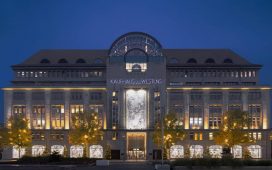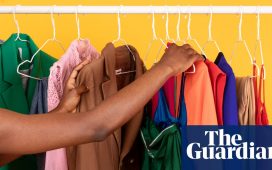As comebacks go, this is probably not the one you’ve been waiting for, but after years of being maligned by most men as more suitable for fancy dress, flared trousers are now being embraced by younger generations, including the likes of Harry Styles.
Flares had their heyday in the 1970s, of course, but now fashion designers such as Gucci, Casablanca, Wales Bonner, Martine Rose and Lemaire have featured the bell-bottomed silhouette in their recent collections. Year-on-year searches for “flares” are up by 43% in the UK and by 33% globally, according to Digital Loft, and on Instagram last week the rapper Travis Scott posed in a pair from Raf Simons’ spring/summer 21 collection while actor Lakeith Stanfield wore a pinstripe pair.

Across the board, 1970s style has been creeping back into the mainstream, with a revival of interior design from that decade, fuelled by TV shows like BBC’s The Serpent – starring Tahar Rahim in flares – and HBO’s The Deuce, and by films set in the era such as Once Upon a Time in Hollywood and Disney’s soon-to-be-released Cruella.
The popularity of flares follows the “kitchen disco” aesthetic of late last year in which men unapologetically channelled Warren Beatty in Shampoo and The Bee Gees. And yet it may still surprise many of us who remember the 70s as the “decade that style forgot”, Prof Andrew Groves from the University of Westminster calls it “a complete cavalcade of good bad taste”.
“It’s been forgotten as stylish for so long, discounted even, that suddenly it’s come full circle,” says Teo van den Broeke, style and grooming director of British GQ. “It feels novel and surprising all over again. The cuts and fabrics are so sexed up and rich that somehow they now feel intensely modern.”
Arashi Yanagawa, the founder of fashion label John Lawrence Sullivan, which has featured flares in its collections, takes it back to the man who put George Harrison in denim flares on the cover of Abbey Road. “Tommy Nutter was my biggest influence,” he says, “I find a beauty and style in the flared silhouette, paired with jackets that shape and cinch the waist.”
Flares “will always be transgressive”, according to Groves. “(They) are forever worn with invisible quotations marks, they persist as fashion’s more out of fashion garment,” he adds. That said, the style is moving from the runway to the high street. “A year ago 88% of flared bottoms stocked in the retail industry came from luxury and premium retailers,” says Edited retail analyst Krista Corrigan, “looking at the breakdown today, the percentage of flared bottoms offered is 18% in the mass market. Retailers like Asos are investing in the trend most significantly”.
But is there deeper meaning behind their popularity? Could there be a link between the recession and the length of our trousers, a ‘trouser length index’?
“The theory is that in times of economic downturn, such as the 70s, manufacturers pushed maxi dresses and flares to sell more fabric,” says Groves. “Today’s flares are being worn both tight and sexy or loose and baggy which I think indicates the financial uncertainly we’re all facing.”
Stylist Christine Nicholson who now works with singer Jazmine Sullivan on her purposefully retro looks thinks flares and the 1970s aesthetic is about escapism. “There was a kind of grandiosity that most people embraced through major revolutionary events during the late 60s and 70s,” she says. “People revert back to the 70s and specifically garments reminiscent of the era because of how free-spirited and cool most people dressed,” she says. “Much like now, there was a collective shift happening that for some can feel burdensome. I think Bill Cunningham got it right when he said ‘Fashion is the armour to survive the reality of everyday life.’”













